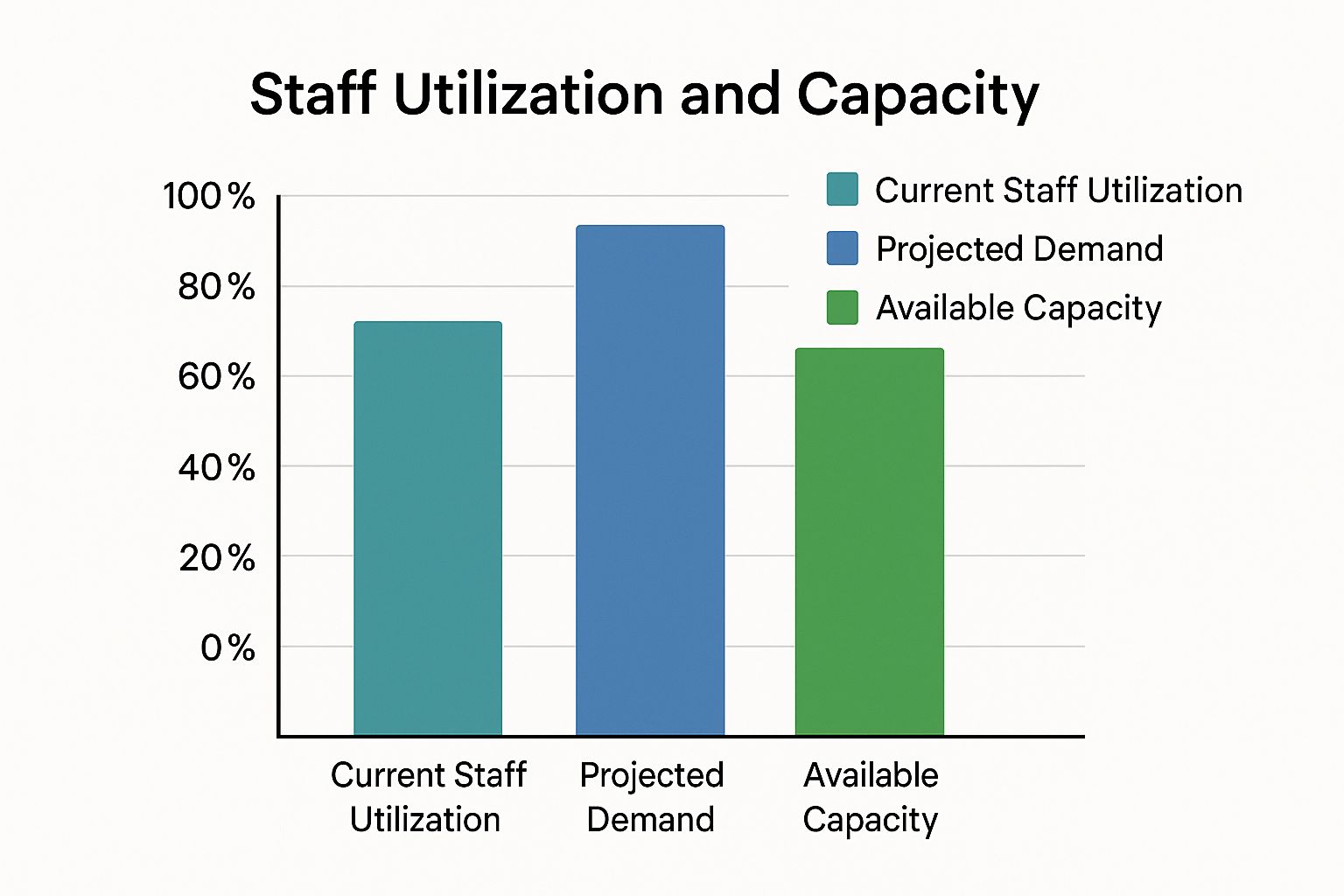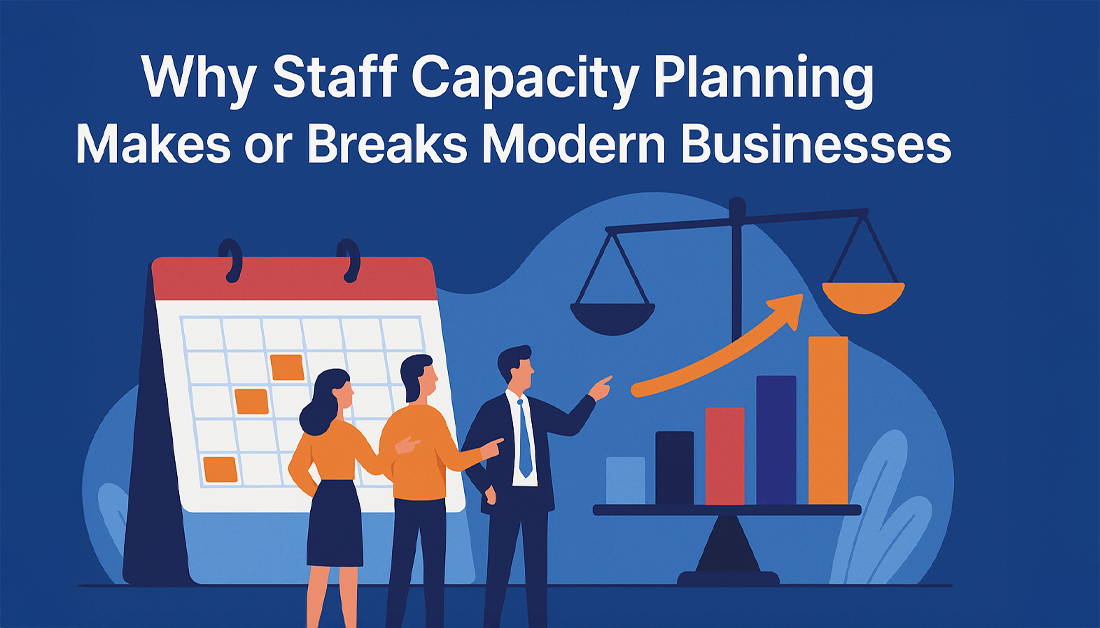Why Staff Capacity Planning Makes or Breaks Modern Businesses

In the competitive business world, organizations constantly strive for efficiency and adaptability. Staff capacity planning plays a vital role in achieving these goals. It ensures businesses have the right talent at the right moment to meet project deadlines and overall objectives. This involves predicting future staffing needs, analyzing current resources, and addressing any discrepancies.
The Importance of Aligning Resources With Demand
Aligning resources with demand is a core function of staff capacity planning. Imagine a software company facing a sudden influx of projects. Without adequate capacity planning, they risk being understaffed. This can result in missed deadlines, employee burnout, and client dissatisfaction. On the other hand, overstaffing leads to wasted resources and lower profits. Capacity planning helps find the sweet spot, ensuring an optimal workforce size for current and future projects.
Capacity planning also highlights skill gaps within a team. This allows organizations to proactively address these gaps through training, recruitment, or upskilling initiatives. This prevents project bottlenecks and ensures teams have the necessary expertise. In essence, capacity planning is key for maximizing efficiency and adapting to market changes. Employee engagement presents a significant challenge, with only 23% of employees reported as engaged. 52% are not engaged, and 15% are actively disengaged. This underscores the importance of capacity planning in addressing workforce issues and improving overall performance. By 2025, strategic workforce planning is expected to be a top priority for HR leaders, highlighting its importance in organizational growth and resilience. Effective capacity planning involves aligning workforce skills with business needs while accounting for turnover and future skill requirements. For more in-depth statistics, check out: Capacity Planning Statistics.
From Reactive to Proactive: The Shift Towards Strategic Workforce Planning
Traditional workforce management often relies on reactive measures, addressing staffing needs only in emergencies. Modern businesses are shifting towards proactive strategic staff capacity planning. This allows them to anticipate future needs and acquire the right resources proactively, avoiding the pitfalls of reactive hiring and downsizing. Interested in learning more about capacity planning within Jira? Check out this resource: How to Master Jira Capacity Planning.
This forward-thinking approach is crucial in today’s dynamic market, allowing businesses to quickly adjust to changing conditions. For example, a company anticipating a seasonal increase in customer demand can use capacity planning to ensure adequate staffing. This helps maintain service levels and customer satisfaction during peak periods.
Beyond Headcount: Considering Skills and Expertise
Effective staff capacity planning goes beyond simply counting employees. It requires a detailed analysis of the skills and expertise needed for specific projects. This involves identifying core competencies, evaluating current skill levels, and developing strategies to acquire or enhance necessary skills. This granular approach ensures projects are staffed with the right people possessing the right expertise. By focusing on both the quantity and quality of the workforce, organizations can maximize productivity, enhance project outcomes, and maintain a competitive edge.
The Explosive Growth Behind Capacity Management Solutions

This infographic illustrates current staff utilization, projected demand, and available capacity. The data clearly shows projected demand exceeding current staff utilization, highlighting a potential resource gap. While available capacity surpasses current utilization, it’s not enough to meet projected demand. This underscores the vital need for strategic staff capacity planning to close this gap and maintain smooth operations. Building the right team is crucial for effective planning. For more information on creating a data-driven team, see this helpful resource on hiring data teams.
Market Forces Driving Investment in Workforce Planning
The increased demand for robust planning isn’t happening by chance. Several market forces are pushing organizations to invest in sophisticated staff capacity planning solutions.
The growth of remote work, for example, introduces new complexities in managing and forecasting workforce needs. This distributed model requires tools offering real-time visibility into employee availability and workload distribution. The increasing reliance on data-driven decision-making across all sectors also contributes to the demand for planning solutions with advanced analytics and forecasting.
The Impact of Predictive Analytics and Workforce Demands
Predictive analytics is revolutionizing staff capacity planning. These tools allow organizations to forecast future workforce needs more accurately, facilitating proactive recruitment and training.
The growing complexity of workforce demands further fuels this growth. As projects become more specialized, organizations need detailed insight into employee skills and expertise for optimal resource allocation. These trends mark a significant shift from reactive workforce management to proactive, strategic planning.
The Capacity Management Market’s Exponential Growth
This shift to strategic capacity planning is driving significant growth in the capacity management market. Currently valued at $1.74 billion in 2024, the market is projected to reach $2.17 billion in 2025, a 24.9% CAGR. This rapid expansion is driven by factors such as the rise of remote work, increasing demand for services in sectors like healthcare, and the growing dependence on real-time data insights. You can find more detailed statistics here.
Digital Transformation and Future Projections
The ongoing digital transformation across industries further emphasizes the need for effective capacity planning. As businesses integrate new technologies and processes, they must ensure their workforce is prepared for these changes.
Looking ahead, the capacity management market is expected to reach $5.21 billion by 2029. This projected growth is fueled by the continued adoption of data-driven decision-making, advanced predictive analytics, and the broader digital transformation of businesses. This growth presents both opportunities and challenges for HR professionals, highlighting the importance of staying informed and adapting to the evolving landscape of staff capacity planning.
Building Your Staff Capacity Planning Framework That Actually Works

Let’s get practical about staff capacity planning. Moving beyond the theory, we’ll focus on building a framework that delivers real results. This means shifting from abstract models to a hands-on, results-driven approach. This section provides a proven methodology for building a framework that truly works.
Demand Forecasting: Grounded in Reality
Accurate demand forecasting is the bedrock of any effective framework. It’s more than just looking at past trends. You need a deep understanding of your business, factoring in seasonal changes, market shifts, and the impact of new product launches or marketing campaigns.
For example, e-commerce businesses can expect a spike in demand during the holidays. This means proactively adjusting their capacity plan. Looking for some practical help? Check out this guide on How to Use Team Capacity Planning Templates.
Capacity Evaluation: More Than Just Headcount
Next, you need to assess your current capacity. This goes beyond simply counting employees. It means understanding your team’s skills, expertise, and availability.
Think about things like planned vacations, training schedules, and even potential attrition. A thorough evaluation gives you a clear view of your existing workforce capabilities. Effective planning requires a structured process. This includes demand forecasting, capacity assessment, and gap analysis, which helps you anticipate where you’ll need additional resources. You can explore more about capacity planning frameworks to deepen your understanding.
Setting the Planning Horizon and KPIs
Establish a planning horizon that matches your business cycles. This could be quarterly, annually, or even longer term depending on your industry and strategic goals. You also need to define clear Key Performance Indicators (KPIs).
These KPIs should directly relate to your business goals and provide useful insights. Tracking metrics like project completion rates, employee utilization, and revenue per employee gives you valuable data for ongoing adjustments.
To help visualize the key components of a robust capacity planning framework, let’s take a look at the table below. It outlines the essential elements, their functions, inputs, expected outcomes, and the complexity involved in implementing them.
Staff Capacity Planning Framework Components
| Framework Component | Primary Function | Key Inputs | Expected Outcomes | Implementation Complexity |
|---|---|---|---|---|
| Demand Forecasting | Predict future resource needs | Historical data, market trends, business strategy | Accurate resource projections | Medium |
| Capacity Evaluation | Assess current resource availability | Team skills, availability, utilization rates | Clear understanding of current capacity | Low |
| Gap Analysis | Identify discrepancies between demand and capacity | Demand forecast, capacity evaluation | Quantifiable resource gaps | Low |
| Planning Horizon | Define the timeframe for the plan | Business cycles, strategic objectives | Time-bound resource allocation | Low |
| KPIs | Measure the effectiveness of the plan | Business goals, resource metrics | Actionable insights for improvement | Medium |
This table highlights how each component contributes to a successful capacity plan. From predicting future needs to measuring outcomes, a structured framework helps ensure you have the right people at the right time.
Building in Flexibility and Review Cycles
Flexibility is essential in your framework. The business landscape is constantly changing, and your plan must adapt. Regular review cycles are key. These allow you to assess the framework’s performance and make adjustments.
This iterative approach keeps your plan relevant and effective.
Involving Stakeholders and Building Buy-In
Collaboration is key for effective staff capacity planning. Include stakeholders from different parts of your organization. This means department heads, project managers, and HR. This collaborative process fosters buy-in and ensures alignment with business objectives. By involving everyone, you create a shared understanding of the planning process and its value. This leads to a stronger and more adaptable organization.
Solving The Biggest Staff Capacity Planning Headaches
Even the best plans for staff capacity planning can hit roadblocks. This section addresses the most common and frustrating challenges HR leaders face. We’ll explore proven strategies to overcome these hurdles, offering practical insights and real-world solutions.
Inaccurate Demand Forecasting: Taming the Unpredictable
One major headache in capacity planning is inaccurate demand forecasting. It’s like planning a party without knowing how many guests to expect. Unexpected market shifts, new product launches, or even seasonal changes can disrupt projections. One common issue is ensuring fair workload distribution, requiring effective strategies for Distribution of Workload.
This means building flexibility into your planning process is key. Regularly review and adjust forecasts to respond to changing demands and stay ahead of the curve.
Stakeholder Resistance and Budget Constraints: Building Buy-In
Two significant roadblocks in staff capacity planning are stakeholder resistance and budget constraints. Stakeholders might be hesitant to adopt new processes, and budget limits can restrict your options.
Building organizational buy-in is essential. Clearly communicate the value of capacity planning using data-driven insights. Show stakeholders how effective planning improves project delivery, cuts costs, and boosts employee satisfaction. For more on capacity planning within Jira, check out this helpful resource: How to Master Capacity Planning with Jira Gadgets and Out-of-Office Management.
Skills Shortages and Rapidly Changing Requirements: Adapting to Change
In today’s fast-paced business world, skills shortages and rapidly changing business requirements are constant challenges. Demand for specialized skills can leave gaps in your workforce, while evolving business needs require continuous adaptation.
Addressing these challenges requires proactive steps like targeted recruitment, upskilling programs, and cross-training. Prioritize flexibility to adapt quickly to evolving business requirements and adjust capacity plans accordingly.
Managing Seasonal Fluctuations and Remote Workforce Complexities
Seasonal fluctuations and remote workforce complexities add another layer of difficulty to capacity planning. Peak seasons may require more staff, while managing a distributed workforce presents unique challenges in tracking availability and workload.
Develop strategies for handling these fluctuations, such as using contingent workers during busy periods or implementing flexible work arrangements for remote employees. Employ effective communication and collaboration tools to maintain visibility into remote team availability and productivity.
Turning Disasters into Success Stories: Learning From Experience
Turning capacity planning disasters into successes hinges on learning from past missteps and adapting. Analyze past failures to identify areas for improvement.
Document lessons learned and incorporate them into future plans. This helps avoid repeating mistakes and strengthens organizational resilience. Embrace continuous improvement to transform capacity planning from a potential problem into a strategic asset.
Technology Solutions That Transform Capacity Planning

Moving beyond spreadsheets, technology offers a powerful set of tools for effective staff capacity planning. This shift from manual processes to automated, data-driven solutions is changing how organizations plan their workforce. This section explores practical solutions, cutting through the marketing jargon. You might be interested in: How to Master HubSpot Jira Integration for Aligning Teams.
Workforce Analytics Platforms: Unveiling Actionable Insights
Workforce analytics platforms are becoming indispensable for capacity planning. These platforms collect and analyze data from multiple sources, providing insights into workforce patterns. For instance, they track employee utilization, identify skill gaps, and forecast future staffing needs based on historical data and projected growth. This empowers organizations to make informed decisions regarding hiring, training, and resource allocation.
AI-Powered Predictive Tools: Enhancing Forecast Accuracy
AI-powered predictive tools represent the next evolution in capacity planning. Using machine learning algorithms, these tools examine historical data to identify complex patterns. This process enhances the accuracy of demand forecasting, allowing organizations to proactively acquire talent before shortages impact projects.
Key Features That Matter
Not all capacity planning tools are equal. A few key features differentiate useful tools from less effective ones.
- Integration Capabilities: Seamless integration with existing HR systems and project management tools like Jira is essential. Look for solutions that offer straightforward data exchange.
- Reporting Functionality: Executives need concise reports. Look for tools offering customizable dashboards that present important metrics like resource utilization, project progress, and projected costs.
Balancing Automation and Strategic Thinking
Leading organizations use automation to streamline capacity planning. This includes automating data collection, report generation, and even some resource allocation. However, human oversight remains crucial. While automation handles routine tasks, strategic decision-making still requires human expertise. The optimal approach combines automation with human input.
Choosing the Right Solution: Practical Evaluation
Choosing the right technology for capacity planning requires careful consideration. The following table provides a comparison of different solutions.
To help you evaluate solutions, we’ve put together a comparison table highlighting key aspects of each approach.
Capacity Planning Technology Solutions Comparison
| Solution Type | Key Features | Best Use Cases | Implementation Cost | ROI Timeline |
|---|---|---|---|---|
| Spreadsheets | Basic tracking and calculations | Small teams with simple projects | Low | Short |
| Project Management Software | Resource allocation and scheduling | Teams managing multiple projects | Medium | Medium |
| Workforce Analytics Platforms | Data analysis and reporting | Organizations seeking data-driven insights | Medium-High | Medium-Long |
| AI-Powered Predictive Tools | Advanced forecasting and optimization | Large organizations with complex projects | High | Long |
A small team with straightforward projects might find spreadsheets sufficient. Larger organizations with complex projects might require more advanced solutions, such as a workforce analytics platform or an AI-powered predictive tool. Choosing the right technology depends on your organization’s specific needs, budget, and long-term goals. By carefully evaluating solutions, organizations can invest in technology that provides real value, leading to data-driven decisions, optimized resource use, and improved business performance.
Measuring Success And Building Continuous Improvement
Staff capacity planning isn’t a static, one-time activity. It’s a continuous journey of refinement and adjustment. This involves establishing clear metrics, gathering feedback, and adapting your strategies to meet evolving business needs. By embracing this ongoing process, you can shift capacity planning from a reactive chore to a proactive driver of success.
Key Metrics and KPIs: Focusing on Business Impact
Measuring the success of your staff capacity planning goes beyond simply counting completed plans. It’s about focusing on Key Performance Indicators (KPIs) that directly reflect the impact on your business.
- Project Completion Rate: This metric tracks how many projects are delivered on time and within budget, revealing how effectively you’re allocating resources.
- Employee Utilization Rate: This measures the percentage of employee time spent on productive work, helping identify bottlenecks and underutilization.
- Revenue per Employee: By connecting capacity planning to the bottom line, this KPI shows how much revenue each employee generates.
- Employee Satisfaction: This crucial metric assesses whether employees feel overwhelmed or underutilized. Remember, happy employees are more productive, and effective capacity planning plays a vital role in creating a positive work environment.
These KPIs provide valuable insights, allowing you to identify areas for improvement and demonstrating the value of capacity planning to leadership.
Establishing Baselines and Setting Realistic Targets
To accurately measure progress, establish baselines. These represent your current performance levels before implementing any changes. Tracking your KPIs against these baselines allows you to quantify the impact of your capacity planning efforts.
When setting targets, focus on achievable, realistic improvements rather than overly ambitious goals. For instance, if your current project completion rate is 60%, aiming for a 5% increase in the next quarter is more realistic and motivating than striving for 90%. This approach nurtures a culture of continuous improvement and prevents discouragement.
Gathering Actionable Feedback: The Human Element
Data is essential, but don’t neglect the human element. Regularly collect feedback from both managers and employees about the effectiveness of your capacity planning. This qualitative data can uncover hidden issues or unforeseen benefits.
- Surveys: Anonymous surveys are a valuable tool for gathering honest feedback on workload distribution, resource availability, and overall satisfaction.
- One-on-One Meetings: Individual meetings with managers and team members provide more in-depth insights into their experiences.
- Focus Groups: Facilitated group discussions can help explore specific aspects of your capacity planning process.
This feedback loop provides crucial insights, enabling you to refine your approach based on real-world experiences. For further insights, check out our article on How to master Jira License Cost Optimization.
Adapting to Change: Embracing Flexibility
The business world is in constant flux, requiring a flexible approach to capacity planning. Regularly review your plan and KPIs, adapting them based on lessons learned, changing market conditions, and evolving organizational needs.
- Market Shifts: Be ready to adjust your plan in response to changes in customer demand, competitor activity, or industry trends.
- Internal Changes: Incorporate factors like organizational restructuring, new product launches, or fluctuations in staffing levels.
- Technology Advancements: Stay current with new technologies that can improve your capacity planning processes.
By embracing adaptability, you ensure your capacity planning stays relevant and effective, even in a dynamic environment.
Communicating Success and Building Sustained Support
Sharing your capacity planning successes is vital for maintaining ongoing support. Communicate your progress to leadership, highlighting the positive impact on key business metrics using clear visuals and concise reports.
- Dashboards: Create dashboards to track KPIs and visualize progress over time. Tools like Power BI can be effective for this.
- Presentations: Present your findings to leadership, emphasizing the value of your work. Consider using Google Slides or Microsoft PowerPoint for engaging presentations.
- Success Stories: Share specific examples of how effective capacity planning has benefited particular projects or teams.
By showcasing your achievements, you build sustained support for your capacity planning initiatives, fostering a culture of continuous improvement and data-driven decision-making.
Improve team productivity and streamline workflows with our Out of Office Assistant for Jira Cloud. Automate handovers, manage absences effectively, and keep projects on track, even when team members are away. Find out more at resolution’s Out of Office Assistant.
